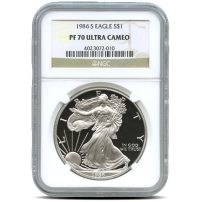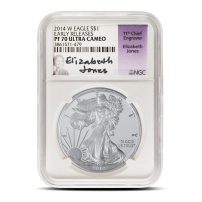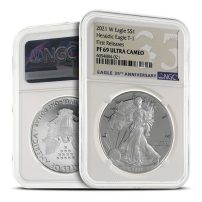




The Proof American Silver Eagle is one piece of the most popular coin program available in the precious metals market today. While the bullion version of the coin, with sales in its version alone in excess of 47 million in 2015, the Proof American Silver Eagle is highly coveted by collectors both at home and abroad.
In terms of value, it is the Proof American Silver Eagle coin that offer the greatest value beyond the denomination issued by the United States government. All American Silver Eagle coins have a face value of $1 (USD). The bullion version of the coin, even with a PCGS certification, has a value just more than the value of the silver content included. However, a Proof PCGS Certified American Silver Eagle coin can have a value that reaches into the thousands for rare, older versions of the coin.
JM Bullion proudly carries a variety of Proof PCGS Certified American Silver Eagle coins in our online catalog. If you’re unfamiliar with the PCGS, its certification process, and common terminology, this page will help improve your knowledge base in the area.
Known formally as the Professional Coin Grading Service, the PCGS was founded in 1985 to provide professional, accurate grading and certification for coins. Together with the Numismatic Guaranty Corporation (NGC), the PCGS is one of the two most respected certification services in the world. The PCGS is located in the United States and offers certification on a variety of bullion and proof coins, including Proof PCGS Certified American Silver Eagle coins.
Prior to the introduction of a numeric scale, rare coin grading was completed based solely upon the physical condition of the coin with just three general categories to include a coin in. Prior to the 1980s, rare coin collectors had only three broad categories to place coins into based upon their condition. These included:
The problem that was created by this system of definitions is that collectors and dealers eventually realized that some Fine coins, for example, were finer than others. In refining the Sheldon Scale and applying it to modern Proof PCGS Certified American Silver Eagle coins, and others, the PCGS found that many buyers were often taken advantage of because of the difficulty in telling the difference between coins of the same category.
The PCGS uses the Sheldon Numeric Scale created in 1948 by Dr. William Sheldon. Dr.. Sheldon was a famed numismatist who developed a scale ranging from 1 to 70 to assign a grade and value to the condition of any coin. A coin with the grade of 1 is the lowest, while 70 represents the highest. In use, a coin with a 70 grade is considered to have a value 70 times that of coin graded 1.
The PCGS stands behind its certifications, offering the following guarantee on its website:
“The PCGS Guarantee of Grade and Authenticity is fundamental to our concept of third-party grading. The cash-back policy ensures the accuracy of the grade assigned to any PCGS coin as long as it remains in its tamper-evident holder. As the owner of a PCGS-graded coin, the customer will have the benefit of PCGS’s Guarantee of Grading Accuracy and Authenticity and each PCGS Authorized Dealer will accept the grades assigned to the coins by PCGS.”
In order to ensure that the coins PCGS Certified American Silver Eagle coins you purchase arrive in their promised condition, the PCGS encapsulates all coins it certifies inside of protective plastic slabs that not only protect the coin from damage, but preserve it for decades to come.
When you shop for PCGS Certified American Silver Eagle coins from JM Bullion, you’re going to encounter many of the terms used by the PCGS to quantify the value of a given coin and qualify it based upon class. For example, the use of Mint State refers to bullion versions of the American Silver Eagle, while PR refers to a graded proof version of the coins. The following are the common terms you can expect to see in our catalog of PCGS Certified American Silver Eagle coins:
On the whole, the PCGS grades coins with the Mint State and Proof (PR) labels ranging from 1 to 70. Today, coins can still be broken into three general categories before being assigned a Sheldon Scale number: circulated, about uncirculated, and uncirculated. The circulated coins have grades from 1 to 45. About Uncirculated coins have grades between 50 and 59, while Uncirculated coins have grades of 60 to 70.
American Silver Eagle coins are the official silver coins of the United States. Initiated in 1986, the American Silver Eagle coin has been available since that date in both bullion and proof. While the bullion coin is a favorite of investors, the finish and beauty of the proof coins make them a must-have for any collectors.
All coins in the Silver Eagle series have the same obverse and reverse design fields. The obverse face of the American Silver Eagle came from the Walking Liberty Half Dollar. Created in 1916 by Adolph A. Weinman during a revolution in American coining, this image of Liberty depicts her in full figure as she strides toward the setting sun.
This particular image of Liberty shows her with the American flag wrapped around her shoulders. With her outstretched right hand, she reaches for the setting sun as a sign of the nation’s determination to find a brighter future. In her left hand, she carries the oak and laurel branches as a sign of America’s civic and military prowess. Weinman’s creation was used on the Walking Liberty Half Dollar from 1916 to 1947.
On the reverse of each Proof American Silver Eagle coin is the image of the heraldic eagle of the United States. This image was first used by designers at the United States Mint in 1794, and over the course of the nation’s history it has been used on a variety of other coins with modern features added at different points in time.
The American Silver Eagle design came in 1986 from then-Chief Engraver of the United States Mint, John Mercanti. His depiction of the heraldic eagle featured sharp, modern lines with the bald eagle set behind the heraldic shield of the country. There are 13 stars arranged in a triangle above the eagle’s head and it holds arrows in one talon and an olive branch in the other.
The Proof American Silver Eagle is produced with a different approach than the bullion version of the coin. First and foremost, the proof coin is struck on special blanks that produce a beautiful finish. Additionally, while the bullion coin is struck to meet demand on an annual basis, the Proof American Silver Eagle is often struck with a limited mintage.
Throughout the early years of the program, the proof version of the Silver Eagle was often capped around 450,000 to 500,000 coins. Some of the highest mintage caps on the Proof American Silver Eagle came in the late 20th and early 21st century when the mint issued limits of 750,000 to 850,000 coins. Today, the mintage cap is not always issued as the mint works harder to accommodate the demand for the Proof American Silver Eagle.
As far as the mint marks you’ll find on Proof American Silver Eagle coins, that depends upon the year of issue. Proof Silver Eagle coins were produced in the San Francisco Mint from 1986 to 1992. Beginning in 1993, the proof coins were struck at the Philadelphia Mint, which continued until 2000. Since 2001, the West Point Mint has handled the production of the Proof American Silver Eagle coin.
There is just one year in which these coins were not struck. In 2009, given the onset of the Great Recession and the intense demand for the bullion version, the Proof American Silver Eagle coin was suspended.
Please don’t hesitate to contact JM Bullion if you have any questions about these Certified Proof Silver Eagles. You can reach out to us on the phone at 800-276-6508, chat with us live online, or email us directly with your inquiries. You can find helpful information regarding acceptable forms of payment and applicable purchasing minimums on our Payment FAQ page. You are always welcome to reach out to our customer service team if you have follow-up questions about payments.